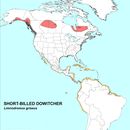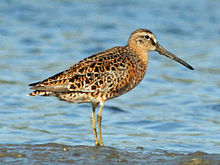en
names in breadcrumbs


A medium-sized (10 ½ - 12 inches) sandpiper, the Short-billed Dowitcher in summer is most easily identified by its mottled gray back, rufous neck, and long bill (although somewhat shorter than the bill of the related Long-billed Dowitcher, Limnodromus scolopaceus). In winter, this species becomes mottled gray above and solid gray below. Field marks visible at any time of year include a conspicuous dark eye-stripe, green legs, and pale belly. Male and female Short-billed Dowitchers are similar to one another in all seasons. The Short-billed Dowitcher breeds in three main populations: the first along the coast of southern Alaska and nearby areas of Canada, the second in the plains of western Canada, and the third along the Hudson Bay east to Quebec. This species is a long-distance migrant, wintering along the coasts from California and the Mid-Atlantic south to northern South America. This species primarily migrates up and down the coasts, and populations that nest in the interior turn inland only after they have reached New England or southern Canada. Short-billed Dowitchers breed in swampy areas of northern forests, often near the tree line at the edge of the tundra. This species is heavily associated with saltwater during the winter, being found on mud flats in salt marshes, coastal lagoons, and shallow mangrove wetlands in the tropics. Short-billed Dowitchers primarily eat small invertebrates, with insects being preferred in summer and small saltwater aquatic animals being preferred in winter. Due to the relative inaccessibility of this species’ breeding grounds, most birdwatchers never observe Short-billed Dowitchers during the summer months. In winter, when this species is more common near populated areas, Short-billed Dowitchers are most easily seen standing on mudflats while probing for food in the mud with their bills. This species is primarily active during the day, but may migrate at night as well as during the day.
A medium-sized (10 ½ - 12 inches) sandpiper, the Short-billed Dowitcher in summer is most easily identified by its mottled gray back, rufous neck, and long bill (although somewhat shorter than the bill of the related Long-billed Dowitcher,Limnodromus scolopaceus). In winter, this species becomes mottled gray above and solid gray below. Field marks visible at any time of year include a conspicuous dark eye-stripe, green legs, and pale belly. Male and female Short-billed Dowitchers are similar to one another in all seasons. The Short-billed Dowitcher breeds in three main populations: the first along the coast of southern Alaska and nearby areas of Canada, the second in the plains of western Canada, and the third along the Hudson Bay east to Quebec. This species is a long-distance migrant, wintering along the coasts from California and the Mid-Atlantic south to northern South America. This species primarily migrates up and down the coasts, and populations that nest in the interior turn inland only after they have reached New England or southern Canada. Short-billed Dowitchers breed in swampy areas of northern forests, often near the tree line at the edge of the tundra. This species is heavily associated with saltwater during the winter, being found on mud flats in salt marshes, coastal lagoons, and shallow mangrove wetlands in the tropics. Short-billed Dowitchers primarily eat small invertebrates, with insects being preferred in summer and small saltwater aquatic animals being preferred in winter. Due to the relative inaccessibility of this species’ breeding grounds, most birdwatchers never observe Short-billed Dowitchers during the summer months. In winter, when this species is more common near populated areas, Short-billed Dowitchers are most easily seen standing on mudflats while probing for food in the mud with their bills. This species is primarily active during the day, but may migrate at night as well as during the day.

The short-billed dowitcher (Limnodromus griseus), like its congener the long-billed dowitcher, is a medium-sized, stocky, long-billed shorebird in the family Scolopacidae.
It is an inhabitant of North America, Central America, the Caribbean, and northern South America.[2] It is strongly migratory; it completely vacates in breeding areas during the snow-bound months.[3] This species favors a variety of habitats including tundra in the north to ponds and mudflats in the south. It feeds on invertebrates often by rapidly probing its bill into mud in a sewing machine fashion.[4] It and the very similar long-billed dowitcher were considered one species until 1950.[5] Field identification of the two American Limnodromus remains difficult today. Distinguishing wintering or juvenile short-billed dowitchers from the long-billed species is very difficult and, even given examination their subtlety different body shapes, cannot always be isolated to a particular species. They differ most substantially in vocalizations. The names of American dowitchers are misleading, as there is much overlap in their bill lengths.[4][5] Only a small percentage can be identified by this character alone.[5]
The short-billed dowitcher was formally described in 1789 by the German naturalist Johann Friedrich Gmelin in his revised and expanded edition of Carl Linnaeus's Systema Naturae. He placed it in the genus Scolopax and coined the binomial name Scolopax grisea.[6] Gmelin based his description on the "brown snipe" from the coast of New York that had been described in 1785 by the English ornithologist John Latham and by the Welsh naturalist Thomas Pennant.[7][8] The short-billed dowitcher is now placed in the genus Limnodromus that was introduced in 1833 by Prince Maximilian of Wied-Neuwied.[9] The genus name combines the Ancient Greek limnē meaning "marsh" with -dromos meaning "-racer" or "-runner". The specific griseus is Medieval Latin meaning "grey".[10] The English name "dowitcher" is from Iroquois and was first recorded in 1841.[11]
Three subspecies are recognised:[12]
The body of adults is dark brown on top and reddish underneath. The tail has a black and white barred pattern. The legs are a yellowish color.
The three subspecies have slight variations in appearance:
None of these combines the reddish belly and barred flanks of the breeding plumage long-billed dowitcher. The winter plumage is largely grey. This bird can range from 23 to 32 cm (9.1 to 12.6 in) in length, 46 to 56 cm (18 to 22 in) in wingspan and 73–155 g (2.6–5.5 oz) in body mass.[13]
The call of this bird is more mellow than that of the long-billed dowitcher, and is useful in identification, particularly of the difficult adult plumages.
The breeding habitat of the short-billed dowitcher includes bogs, tidal marshes, mudflats or forest clearings south of the tree line in northern North America. L. g. griseus breeds in northern Quebec; L. g. hendersoni breeds in north central Canada; L. g. caurinus breeds in southern Alaska and southern Yukon.
The birds migrate to the southern United States and as far south as Brazil. This bird is more likely to be seen near ocean coasts during migration than the long-billed dowitcher. This species occurs in western Europe only as an extremely rare vagrant.
These birds nest on the ground, usually near water. Their nests are shallow depressions in clumps of grass or moss, which are lined with fine grasses, twigs and leaves. They lay four, sometimes three, olive-buff to brown eggs. Incubation lasts for 21 days and is done by both sexes.
The downy juvenile birds leave the nest soon after hatching. Parental roles are not well known, but it is believed the female departs and leaves the male to tend the chicks, which find all their own food.
These birds forage by probing in shallow water or on wet mud. They mainly eat insects, mollusks, crustaceans and marine worms, but also eat some plant material.
 In breeding plumage
In breeding plumage  Adult in foreground, red knot in background
Adult in foreground, red knot in background The short-billed dowitcher (Limnodromus griseus), like its congener the long-billed dowitcher, is a medium-sized, stocky, long-billed shorebird in the family Scolopacidae.
It is an inhabitant of North America, Central America, the Caribbean, and northern South America. It is strongly migratory; it completely vacates in breeding areas during the snow-bound months. This species favors a variety of habitats including tundra in the north to ponds and mudflats in the south. It feeds on invertebrates often by rapidly probing its bill into mud in a sewing machine fashion. It and the very similar long-billed dowitcher were considered one species until 1950. Field identification of the two American Limnodromus remains difficult today. Distinguishing wintering or juvenile short-billed dowitchers from the long-billed species is very difficult and, even given examination their subtlety different body shapes, cannot always be isolated to a particular species. They differ most substantially in vocalizations. The names of American dowitchers are misleading, as there is much overlap in their bill lengths. Only a small percentage can be identified by this character alone.